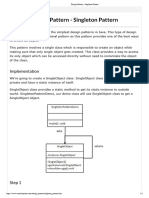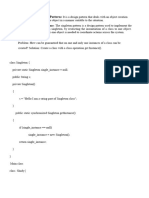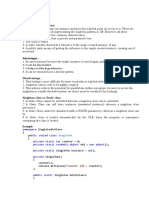0% found this document useful (0 votes)
24 views3 pagesSingleton Design Pattern
The Singleton Design Pattern is a creational pattern that restricts a class to a single instance and provides a global access point to it, typically through a static method called `getInstance()`. It is useful for coordinating actions across a system and managing shared resources, but can introduce challenges such as global state, tight coupling, and scalability issues. An example implementation in Java demonstrates the use of a private constructor and a static instance variable to ensure only one instance is created.
Uploaded by
91panicle-toucansCopyright
© © All Rights Reserved
We take content rights seriously. If you suspect this is your content, claim it here.
Available Formats
Download as PDF, TXT or read online on Scribd
0% found this document useful (0 votes)
24 views3 pagesSingleton Design Pattern
The Singleton Design Pattern is a creational pattern that restricts a class to a single instance and provides a global access point to it, typically through a static method called `getInstance()`. It is useful for coordinating actions across a system and managing shared resources, but can introduce challenges such as global state, tight coupling, and scalability issues. An example implementation in Java demonstrates the use of a private constructor and a static instance variable to ensure only one instance is created.
Uploaded by
91panicle-toucansCopyright
© © All Rights Reserved
We take content rights seriously. If you suspect this is your content, claim it here.
Available Formats
Download as PDF, TXT or read online on Scribd
/ 3


































































